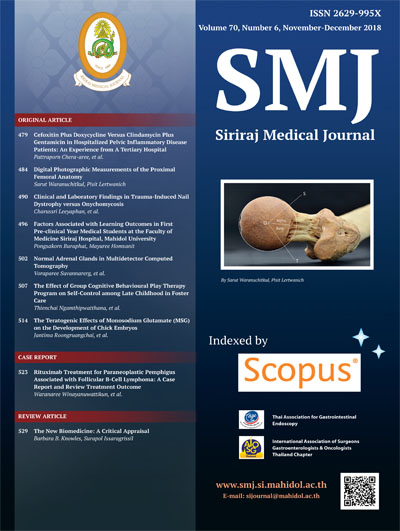Cefoxitin Plus Doxycycline Versus Clindamycin Plus Gentamicin in Hospitalized Pelvic Inflammatory Disease Patients: An Experience from A Tertiary Hospital
Keywords:
Antibiotics; cefoxitin plus doxycycline; clindamycin plus gentamicin; pelvic inflammatory disease; tubo-ovarian abscessAbstract
Objective: To compare length of hospital stay (LOS) and surgical rate in patients hospitalized with pelvic inflammatory disease (PID) who received either cefoxitin plus doxycycline regimen or clindamycin plus gentamicin regimen.
Methods: Medical records of patients hospitalized with PID from 2004 to 2011 were reviewed. Study population was women aged 14-40 years old who had a first-time, admitted diagnosis and a discharged diagnosis of PID. Patients who had prior hysterectomy, bilateral salpingectomy and were not sexually active were excluded. The patients received either intravenous cefoxitin (2 grams every 6 hours) plus oral doxycycline (100 mg twice a day) regimen or intravenous clindamycin (900 mg every 8 hours) plus gentamicin (240 mg once daily) regimen. Outcomes of interest were LOS and surgical rate.
Results: Of 252 eligible participants, 141 (55.95%) received cefoxitin plus doxycycline and 111 (44.05%) received clindamycin plus gentamicin. The patients receiving cefoxitin plus doxyclycline had statistically significant lower age and less number of cases of tubo-ovarian abscess (TOA) (P<0.05). Logistic regression showed the similar LOS and surgical rate in both groups after adjusted with age and TOA. No severe adverse effect was identified in both regimens.
Conclusion: Cefoxitin plus doxycycline regimen appears as effective as clindamycin plus gentamicin regimen for treating hospitalized PID patients in terms of LOS, surgical rate and safety profile.
Downloads
Published
How to Cite
Issue
Section
License
Authors who publish with this journal agree to the following conditions:
Copyright Transfer
In submitting a manuscript, the authors acknowledge that the work will become the copyrighted property of Siriraj Medical Journal upon publication.
License
Articles are licensed under a Creative Commons Attribution-NonCommercial-NoDerivatives 4.0 International License (CC BY-NC-ND 4.0). This license allows for the sharing of the work for non-commercial purposes with proper attribution to the authors and the journal. However, it does not permit modifications or the creation of derivative works.
Sharing and Access
Authors are encouraged to share their article on their personal or institutional websites and through other non-commercial platforms. Doing so can increase readership and citations.











